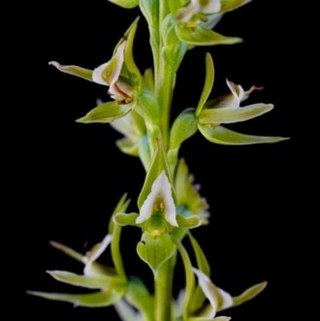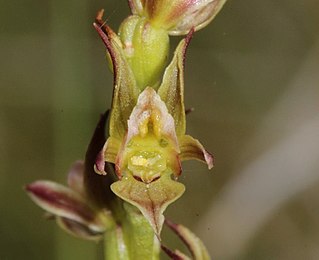Prasophyllum correctum, commonly known as the gaping leek orchid or Bairnsdale leek orchid, is a species of orchid species endemic to a small region in Victoria. It has a single dark green, tube-shaped leaf and up to twenty strongly scented, yellowish-green flowers and is only known from railway reserves near Bairnsdale.

Prasophyllum montanum, commonly known as the mountain leek orchid, is a species of orchid endemic to eastern Australia. It has a single tubular, green leaf and up to fifty scented, greenish to pinkish flowers. It grows in montane ecosystems at altitudes above 1,500 m (5,000 ft).
Prasophyllum candidum, commonly known as the Kiandra leek orchid, is a species of orchid endemic to eastern Australia. It has a single tubular, yellowish-green leaf and up to forty scented, bright white to greenish flowers. It grows in subalpine areas at altitudes above 1,000 m (3,000 ft) in New South Wales and Victoria although in the latter state it is considered to be a form of P. odoratum.

Prasophyllum caudiculum, commonly known as the Guyra leek orchid, is a species of orchid endemic to a small area of northern New South Wales. It has a single tubular, bright green leaf and up to thirty five greenish to reddish-brown flowers crowded along an erect flowering stem. It grows in grassy places near Guyra.

Prasophyllum frenchii, commonly known as the maroon leek orchid or swamp leek orchid, is a species of orchid endemic to south-eastern continental Australia. It has a single tubular green leaf and up to sixty five green, reddish-brown or red flowers. Formerly more widespread, it is now confined to seven populations containing a total of fewer than 1,000 plants.
Prasophyllum litorale, commonly known as the coastal leek orchid, is a species of orchid endemic to southern continental Australia. It has a single tubular leaf and up to forty flowers with red and green colouring and grows in sandhills near the sea.
Prasophyllum occultans, commonly known as the hidden leek orchid, is a species of orchid endemic to southern Australia. It has a single, smooth, tube-shaped leaf with a reddish-purple base and up to ten greenish flowers. It is a rare species found only in a few locations in South Australia and in far western Victoria.

Prasophyllum patens, commonly known as the broad-lipped leek orchid or sandstone leek orchid, is a species of orchid endemic to the Sydney region of New South Wales. It has a single tubular green leaf and up to thirty green to greenish-brown, lemon-scented flowers with a white labellum.
Prasophyllum fitzgeraldii, commonly known as FitzGerald's leek orchid, is a species of orchid endemic to South Australia. It has a single tube-shaped leaf and up to thirty five green or reddish-brown flowers with a pink to purple labellum. It was previously thought to also occur in Victoria.
Prasophyllum roseum, commonly known as the pink lip leek orchid, is a species of orchid endemic to southern continental Australia. It has a single tube-shaped leaf and up to thirty greenish flowers with a pink labellum. It is a recently described plant, previously included with P. fitzgeraldii, but distinguished from that species by its smaller, less crowded flowers, with more spreading lateral sepals and different labellum callus. It grows in the south-east of South Australia and in western Victoria.
Prasophyllum spadiceum, commonly known as the brown lip leek orchid, is a species of orchid endemic to southern continental Australia. It has a single tube-shaped leaf and up to thirty pale green, brown and white flowers with a whitish labellum. It is a recently described plant, previously included with P. fitzgeraldii, but distinguished from that species by its smaller, paler flowers, whitish labellum and brown callus. It grows in the south-east of South Australia and in a single location in western Victoria.
Prasophyllum crassum is a species of orchid endemic to South Australia. It has a single tube-shaped leaf and up to fifteen greenish and pinkish-brown flowers with a whitish labellum. It is a recently described plant, previously included with P. fitzgeraldii, but distinguished from that species by its smaller number of smaller, less colourful flowers and different labellum shape. It grows in the south-east of the state and usually only appears after fire.
Prasophyllum tortilis is a species of orchid endemic to South Australia. It has a single tube-shaped leaf and up to ten purplish-brown and green flowers with a purple labellum. It is a recently described plant, previously included with P. fitzgeraldii, but distinguished from that species by its smaller number of smaller, more darkly coloured, short-lived flowers. It also resembles P. goldsackii but has fleshier flowers than that species.
Prasophyllum stygium, commonly known as the elfin leek orchid, is a species of orchid endemic to Victoria. It has a single tube-shaped leaf and up to twenty greenish-brown flowers with a white labellum. It is a recently described plant, previously included with P. fitzgeraldii, but distinguished from that species by its greenish-brown flowers with their white labellum and narrower brown callus. It is only known from a single population of about thirty plants.
Prasophyllum occidentale, commonly known as the plains leek orchid, is a species of orchid endemic to southern continental Australia. It has a single tubular leaf and up to twenty five small, pale yellowish-green flowers. It is found in South Australia and Victoria although regarded by some taxonomists as a South Australian endemic.
Prasophyllum collinum is a species of orchid endemic to South Australia. It has a single tubular leaf and up to thirty lemon-scented, greenish brown and white flowers. It is only known from the Eyre Peninsula where it grows in sparse woodland.
Prasophyllum brevisepalum is a species of orchid endemic to New South Wales. It has a single tubular, shiny dark green leaf and up to thirty five scented, yellowish to brownish green and white flowers. It is only known from a single population growing in woodland near Inverell.
Prasophyllum holzingeri is a species of orchid endemic to New South Wales. It has a single tubular, shiny dark green leaf and up to fifteen unscented, greenish to brownish pink and white flowers. It is only known from a few populations in the Barrington Tops area.
Prasophyllum pictum is a species of orchid endemic to New South Wales. It has a single tubular, shiny dark green leaf and up to twenty two scented brown, pink, purple and white flowers. It is only known from three subpopulations on the Northern Tablelands.
Prasophyllum pilligaense is a species of orchid endemic to New South Wales. It has a single tubular, shiny dark green leaf and up to thirty scented greenish brown to brownish and white flowers. It is only known from a few populations in the Coonabarabran district.



